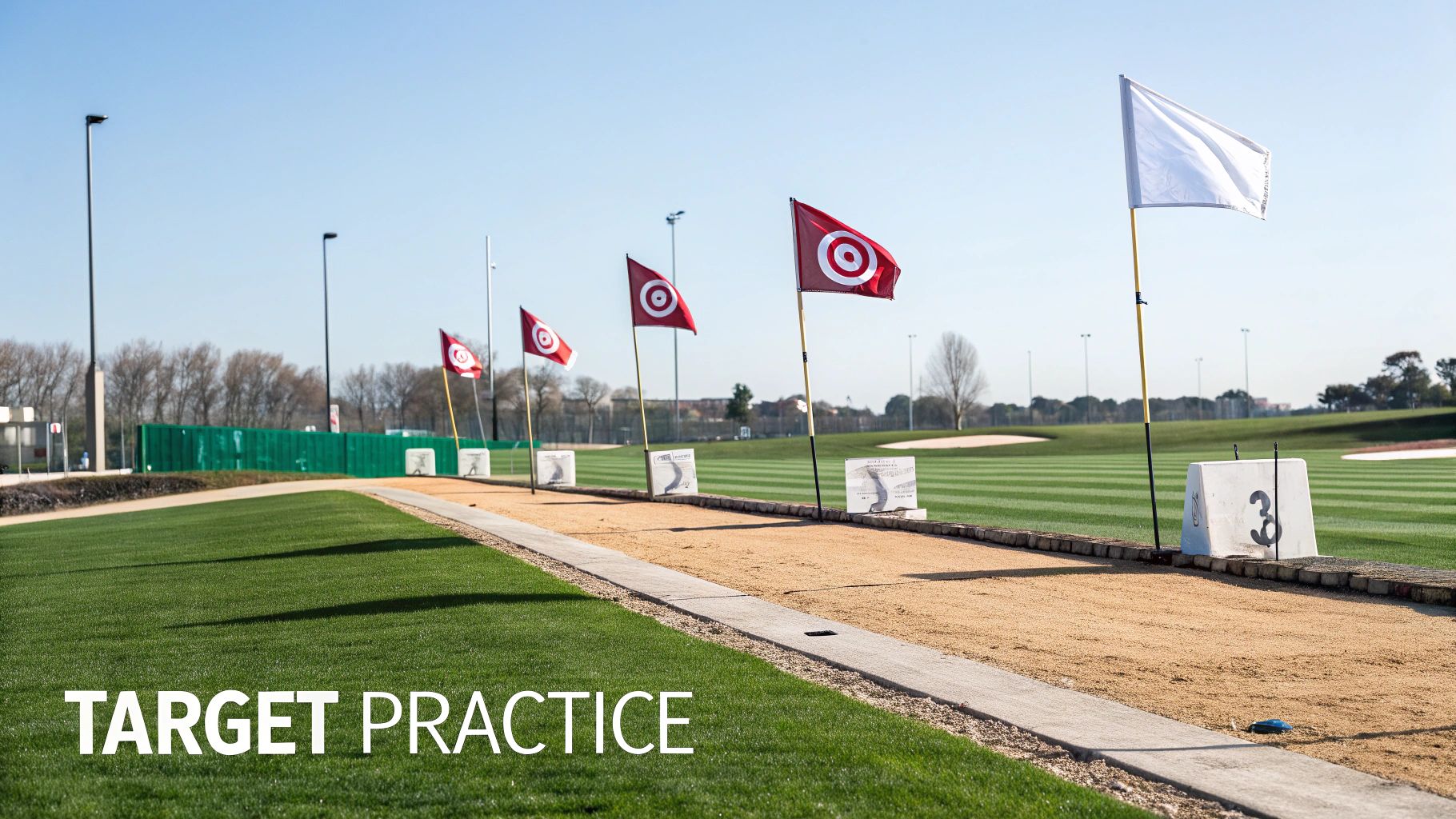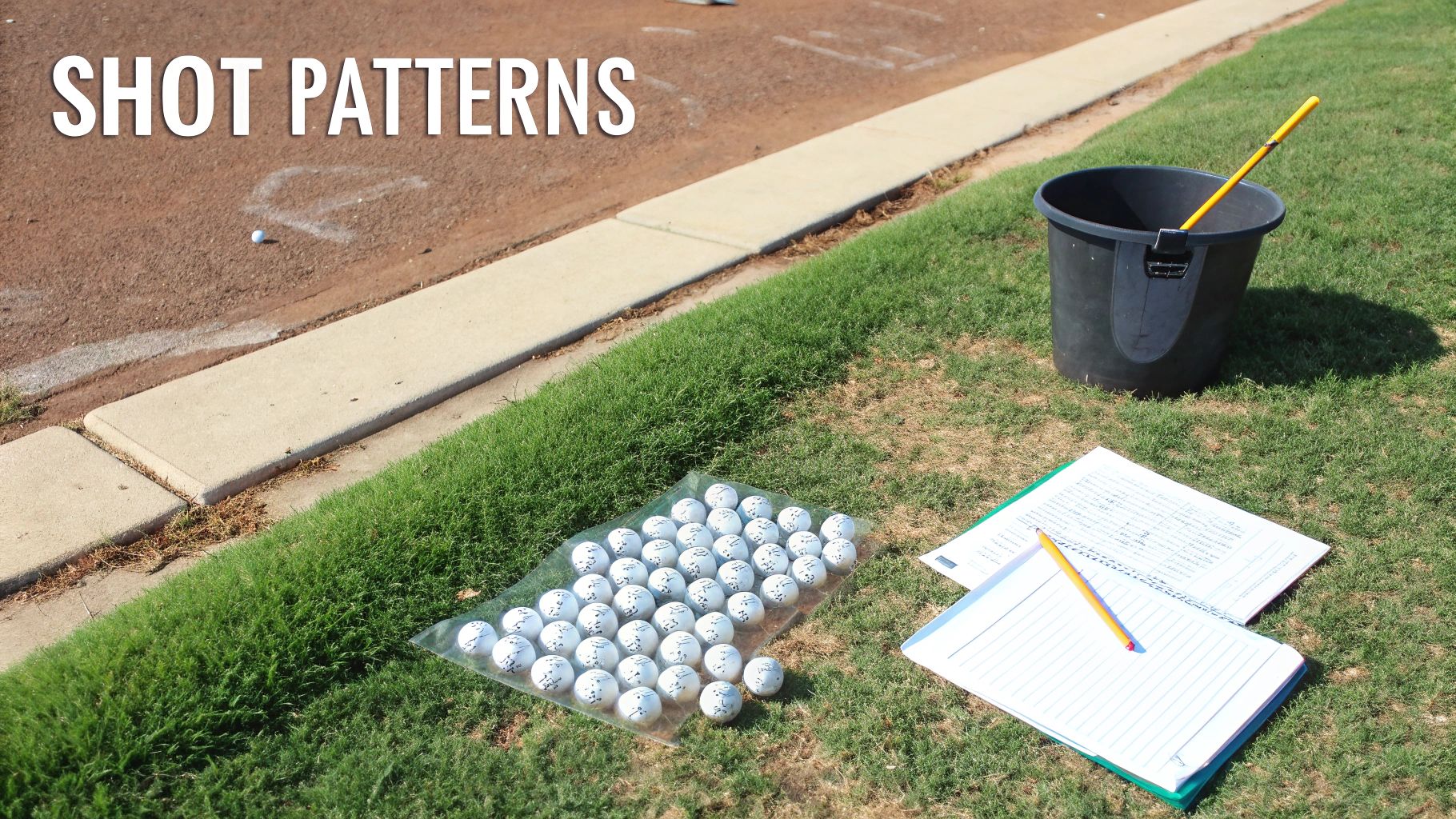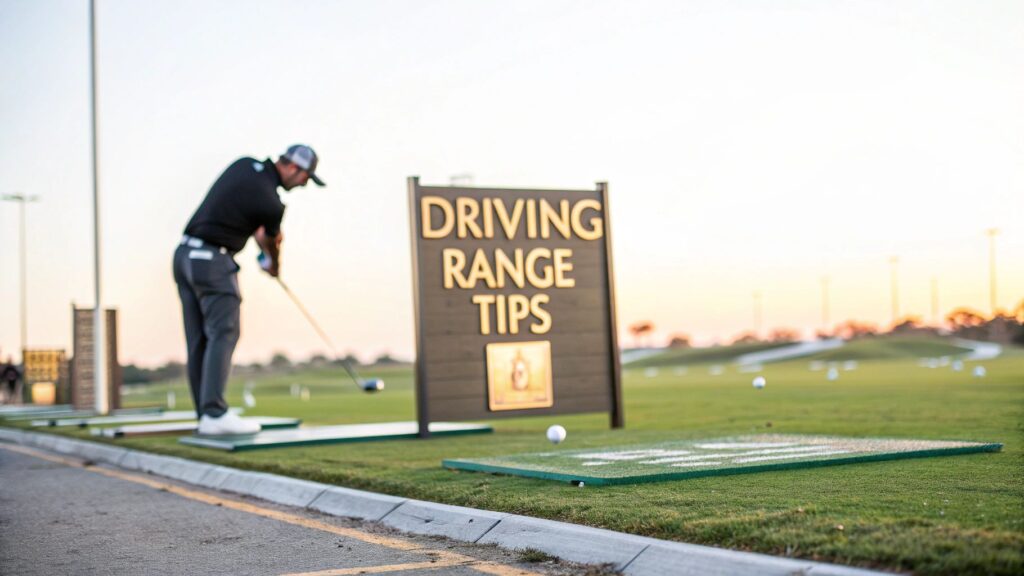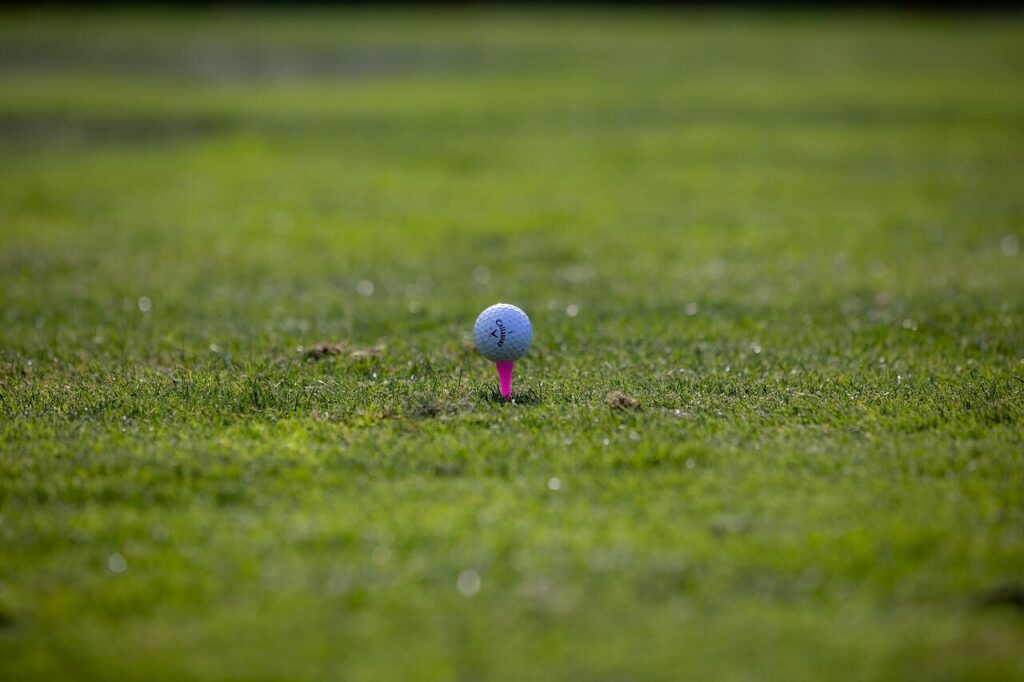The driving range can be a golfer’s greatest tool or their biggest waste of time. While the rhythmic thwack of a perfectly struck driver is satisfying, mindlessly whaling on bucket after bucket rarely shaves strokes off your score. The real difference between a casual player and someone who consistently improves often boils down to one thing: purposeful practice. This guide is for the golfer who’s ready to move beyond just ‘warming up’ and start using the range to build real, lasting skills.
We’re diving deep into eight actionable golf driving range tips that focus on smart strategy, mental discipline, and tangible improvement. Forget the generic advice you’ve heard a thousand times. These are the specific, structured methods that dedicated players use to turn practice sessions into results they can see on the scorecard. You’ll learn how to make every shot count with target-based drills, replicate on-course pressure, understand your shot patterns, and dial in your swing tempo.
Each tip is designed to be immediately useful, helping you build a practice framework that actually improves your game where it counts. Let’s transform your range time from a simple habit into your secret weapon for confident, consistent golf.
- 1. Target-Based Practice Drills
- 2. The 80/20 Distance Distribution
- 3. Pre-Shot Routine Replication
- 4. Swing Tempo and Rhythm Training
- 5. Shot Pattern Analysis and Clustering
- 6. Environmental Variable Adaptation
- 7. Progressive Distance and Difficulty Sequencing
- 8. Mental Game and Pressure Simulation
- 8-Point Comparison: Driving Range Tips
- Take Your Practice from the Mat to the Course
The driving range can be a golfer’s greatest tool or their biggest waste of time. While the rhythmic thwack of a perfectly struck driver is satisfying, mindlessly whaling on bucket after bucket rarely shaves strokes off your score. The real difference between a casual player and someone who consistently improves often boils down to one thing: purposeful practice. This guide is for the golfer who’s ready to move beyond just ‘warming up’ and start using the range to build real, lasting skills.
We’re diving deep into eight actionable golf driving range tips that focus on smart strategy, mental discipline, and tangible improvement. Forget the generic advice you’ve heard a thousand times. These are the specific, structured methods that dedicated players use to turn practice sessions into results they can see on the scorecard. You’ll learn how to make every shot count with target-based drills, replicate on-course pressure, understand your shot patterns, and dial in your swing tempo.
Each tip is designed to be immediately useful, helping you build a practice framework that actually improves your game where it counts. Let’s transform your range time from a simple habit into your secret weapon for confident, consistent golf.
1. Target-Based Practice Drills
Let’s be honest: one of the biggest mistakes golfers make is hammering a large bucket of balls into a vast, open field. This “grip it and rip it” approach feels good but builds sloppy habits and does very little to improve on-course performance. The fix? A structured, target-based practice routine. This method transforms your practice from a random activity into a focused skill-development session centered on accuracy and distance control.

The concept is simple: instead of just hitting balls, you aim every single shot at a specific, predetermined target. This simple shift mimics the pressure and precision required on the actual golf course, where every swing has a purpose. By focusing on a flag, a yardage marker, or even a specific patch of grass, you train your brain and body to work together to produce a desired result. This is one of the most effective golf driving range tips for players who want to see a real drop in their scores.
How to Implement Target-Based Drills
Getting started is easy. The key is to dedicate the majority of your time to the shots that matter most.
- Prioritize Scoring Clubs: Spend at least 60% of your practice time hitting shots to targets within 150 yards. This is where most strokes are saved on the course.
- Create Imaginary Fairways: For your driver and woods, pick two distant markers (like a flag and a bunker) and treat the space between them as a fairway. Your goal isn’t just distance; it’s hitting within that defined zone.
- Track Your Performance: Use a small notebook or a notes app on your phone. For a set of 10 balls aimed at the 150-yard flag, how many landed within 10 yards left, right, short, or long? This simple data reveals your common misses and helps you make smart adjustments.
By treating each shot as if it matters, you’ll build the consistency and mental focus needed to excel under pressure.
2. The 80/20 Distance Distribution
Most amateur golfers get it backward at the range. They spend the bulk of their time smashing drivers and long irons—the clubs that feel most powerful but account for a small percentage of their total shots. The 80/20 Distance Distribution flips this habit on its head. This powerful strategy, championed by short-game gurus like Dave Pelz, suggests spending 80% of your practice time on the clubs that get you on the green and close to the pin—your wedges and short irons.
The logic is rooted in scoring reality: your wedges and short irons are your money clubs. A great drive feels amazing, but a poorly hit 75-yard wedge shot can erase that advantage in a heartbeat. This principle forces you to dedicate your effort to the shots that have the biggest impact on your scorecard. Adopting this approach is one of the most transformative golf driving range tips for players serious about lowering their handicap, as it directly addresses the shots that separate good scores from great ones.
How to Implement the 80/20 Rule
Shifting your focus requires a conscious change in how you use your range balls and time. Instead of starting with the driver, start from the green and work your way back.
- Prioritize Wedges and Short Irons: Dedicate the first 30-40 minutes of your session exclusively to your wedges, 9-iron, and 8-iron. Practice hitting to specific yardages (e.g., 50, 75, 100, 125 yards), focusing on precision over raw power. This builds the muscle memory needed for deadly accurate approach shots.
- Limit Your Driver Time: Allocate only about 15 minutes or a small fraction of your bucket to the driver. When you do hit it, use the imaginary fairway drill mentioned earlier. The goal is to build a reliable, repeatable swing, not to hit your absolute max distance every time.
- Vary Your Lies and Targets: If your range has a grass area, practice hitting your scoring clubs from different lies. This simulates real on-course conditions and prepares you for the imperfect situations you’ll inevitably face. Always aim at a specific flag or marker to keep your practice purposeful.
By focusing on proximity to the hole rather than raw distance, you train yourself to be a better scorer—which is the entire point of the game.
3. Pre-Shot Routine Replication
Ever wonder why your smooth, rhythmic range swing turns into a tense, inconsistent mess on the course? The cause is often a lack of mental and physical continuity. The solution is to replicate your on-course pre-shot routine with every single ball you hit during practice. This simple discipline bridges the gap between practice and performance, training your mind and body to treat every shot with the same focused intention.

This means performing the exact same sequence of actions before each range shot as you would before a critical approach on the 18th hole. Stand behind the ball, pick your target, take a couple of practice swings, align your body, and then swing. By ingraining this ritual, you create a psychological trigger that signals it’s time to focus, making the driving range an extension of the course. This is one of the most powerful golf driving range tips for building consistency under pressure, and it’s a non-negotiable for pros like Tiger Woods and Rory McIlroy.
How to Implement Pre-Shot Routine Replication
Making this a habit requires discipline and a shift away from rapid-fire hitting. Slow down and make every shot count.
- Step Away After Every Shot: Instead of raking another ball over, step back, reset, and begin your entire routine from scratch for the next shot. This simulates the walking and waiting that happens between shots on the course.
- Time Your Routine: A consistent routine should take a similar amount of time, typically 20-30 seconds. This prevents rushing during practice and overthinking during a real round.
- Vary Your Clubs and Targets: Don’t hit 20 consecutive 7-irons. Hit a driver, then an 8-iron, then a wedge. This forces you to adapt your routine for different shots, just as you would during a round.
- Practice Under Imagined Pressure: For the last five balls in your bucket, create a scenario. For example: “This is a tee shot on a tight par 4 to win the match.” Go through your full routine and execute. This adds a powerful layer of mental conditioning.
By making your pre-shot routine an automatic, non-negotiable part of every swing, you build a foundation of consistency that holds up when it really matters.
4. Swing Tempo and Rhythm Training
One of the most elusive yet critical elements of a great golf swing is a consistent tempo. Many amateurs obsess over mechanics and power, but they neglect the rhythm that glues the entire motion together. Developing a repeatable swing tempo is a game-changer that builds consistency, improves accuracy, and maximizes your distance control. This focus on cadence, rather than brute force, is often what separates the pros from the rest of us.

The idea is to train your swing to a specific, rhythmic count, much like a musician follows a metronome. This prevents the rushed, jerky swings that lead to mishits, especially when you’re under pressure. Think of the famously smooth rhythm of Ernie Els; his swing is a perfect example of a controlled, unhurried motion that generates effortless power. By ingraining a consistent tempo at the driving range, you create a reliable foundation for every club in your bag, making this one of the most effective golf driving range tips for long-term improvement.
How to Implement Swing Tempo Training
Integrating tempo drills into your practice is simple and incredibly effective. The goal is to find a rhythm that works for you and then make it second nature.
- Use a Metronome App: Download a free metronome app on your phone and set it between 60-80 beats per minute (BPM). Use a three-beat count: “one” for the takeaway, “two” for the top of your backswing, and “three” for impact.
- Establish a Ratio: Most tour pros have a backswing-to-downswing ratio of about 3:1. This means the backswing takes three times as long as the downswing. A metronome helps you feel and internalize this crucial timing.
- Record and Review: Film your swing from the side while using the metronome. Watching the playback will give you immediate, honest feedback on whether your movements are truly syncing with the beat you’re trying to establish.
By dedicating even a portion of your practice to tempo, you’ll develop a smoother, more powerful, and far more reliable swing.
5. Shot Pattern Analysis and Clustering
Hitting balls without understanding where they consistently go is like driving without a map. Shot pattern analysis is the simple process of tracking where your shots land to identify your common misses—like that consistent slice with your driver or a pull with your mid-irons. This data-driven approach moves you beyond just noticing a bad shot to actually diagnosing the root cause of your swing flaws. By clustering your shots, you reveal the systematic tendencies that allow for targeted, effective corrections.

This concept is used by every elite player, often with sophisticated launch monitors that provide detailed dispersion charts. But you don’t need expensive equipment to benefit. The goal is to collect honest feedback on your swing’s output. Noticing that eight out of ten 7-iron shots landed short and right of the target provides a clear, undeniable piece of data. This is one of the most powerful golf driving range tips because it replaces guesswork with facts, guiding your practice with purpose.
How to Implement Shot Pattern Analysis
Start by dedicating a portion of your practice bucket to deliberate data collection. The goal is to gather enough information to see a clear trend.
- Practice in 10-Ball Clusters: For a specific club and target, hit a set of 10 balls. After the set, step back and analyze the grouping. Where is the center of your cluster? How wide is the dispersion?
- Keep Detailed Notes: Use a notebook or a notes app to log your findings. For example: “Driver: 7/10 balls faded right of target fairway,” or “Pitching Wedge: 6/10 balls landed 10 yards short.” This log becomes an invaluable reference for future sessions.
- Use Visual Aids: If your range allows, place an alignment stick a few feet in front of your ball on your target line. This helps you confirm whether your shots are starting on your intended line before they curve.
- Adjust Immediately: Once you identify a consistent pattern, make one small adjustment. If you have a persistent slice, for instance, focus on strengthening your grip for the next 10-ball set and see if the pattern changes.
This analytical approach transforms your range time from a simple physical exercise into an intelligent diagnostic session, ensuring every swing moves you closer to a more consistent game.
6. Environmental Variable Adaptation
Many golfers fall into the trap of only practicing in perfect, calm conditions. This creates a false sense of confidence that quickly shatters when you face a windy afternoon or an early morning chill on the course. To build a truly resilient game, you have to practice adapting to environmental variables. This means deliberately exposing yourself to the very conditions that can derail a good round, turning potential weaknesses into strengths.
The idea is simple: learn how wind, temperature, and even lighting affect your ball flight and club selection. Pro golfers don’t just hope for good weather; they prepare for all possibilities. By practicing in less-than-ideal conditions, you develop the feel and strategic awareness needed to manage your game when the elements are a factor. This approach is one of the most overlooked yet impactful golf driving range tips for building a reliable, all-weather game.
How to Practice Environmental Adaptation
Instead of avoiding the range on windy or cold days, start treating those as prime practice opportunities. Your goal is to observe, learn, and adjust.
- Embrace the Wind: Deliberately head to the range when it’s windy. Hit shots into a headwind, with a tailwind, and with crosswinds from both directions. Notice how much a 10-mph wind changes your 7-iron’s distance and direction. For more in-depth strategies, you can learn how to master windy golf conditions.
- Factor in Temperature: Pay attention to how the ball flies on a cool 50°F (10°C) day versus a hot 85°F (30°C) day. Colder, denser air reduces carry distance. Understanding this effect prevents you from coming up short on approach shots during a chilly morning round.
- Vary Your Lighting: Practice during the low-light conditions of early morning or late evening. This trains your eyes to track the ball against different backgrounds and prepares you for those tee times at the very beginning or end of the day.
By intentionally practicing in varied environments, you transform unpredictable conditions from a threat into a manageable part of the game.
7. Progressive Distance and Difficulty Sequencing
Too many golfers arrive at the range, immediately pull out their driver, and start swinging for the fences. Or they randomly jump between clubs without a plan. This chaotic approach hinders skill development. A far more effective method is to structure your practice using progressive distance and difficulty sequencing. This principle, drawn from elite athletic training, involves starting with simpler, shorter shots and gradually increasing the complexity and length as you find success.
The idea is to build a solid foundation of confidence and repeatable mechanics with easier shots before moving on to more challenging ones. This smart approach optimizes how your brain learns and refines motor skills, ensuring you groove a proper swing rather than reinforcing bad habits. By mastering a 50-yard pitch before attempting a 150-yard iron shot, you build a “ladder” of competence, making each subsequent step feel more manageable. This is one of the most powerful golf driving range tips for building lasting consistency from the ground up.
How to Implement Progressive Sequencing
Applying this method requires a pre-planned session structure. Instead of aimless hitting, you follow a deliberate, step-by-step process.
- Start Short and Simple: Begin every practice session with your wedges. Hit 10-15 balls to a 50-yard target, focusing purely on solid contact and rhythm. Don’t move on until you feel dialed in.
- Create “Success Gates”: Set a clear performance benchmark for advancing. For example, you must land 5 out of 7 shots within your target zone at 75 yards before you allow yourself to move up to 100 yards. This gamifies the process and ensures you earn the right to tackle a harder shot.
- Incorporate Pressure: In the final phase of your practice, add a layer of difficulty that mimics on-course pressure. Try a drill where you have to hit a “green” (a designated target area) with one ball before you can go home. This trains you to perform when it counts.
- Track Your Progress: Keep a simple log of your sessions. Note which distances you mastered and where you struggled. This data will inform your next practice plan and highlight areas needing more work.
8. Mental Game and Pressure Simulation
What’s the biggest disconnect for amateur golfers? It’s the gap between their relaxed, free-swinging range performance and their tense, high-stakes on-course reality. The driving range often fails to replicate the mental stress that causes mishits and poor decisions. To bridge this gap, you have to incorporate pressure simulation into your practice. This technique trains your mind to perform when it matters most, making practice feel as consequential as a real round.
The core principle is to create artificial consequences for each shot, forcing you to focus with the same intensity you would on the course. Instead of hitting balls without purpose, you assign meaning and stakes to specific swings, building mental resilience and a reliable pre-shot routine. By intentionally making practice uncomfortable, you normalize the feeling of pressure, so it no longer derails your game during a competitive round. This is one of the more advanced golf driving range tips that can lead to a significant breakthrough in your performance.
How to Implement Pressure Simulation
Integrating mental challenges into your routine requires creativity and discipline. The goal is to make your mind work just as hard as your body.
- Create Stakes-Based Games: Invent a penalty for missing a target. For example, if you don’t land your shot within an imaginary fairway, you have to do five push-ups or hit five perfect wedge shots before moving on. The “cost” of failure sharpens your focus.
- Simulate a Finishing Stretch: Dedicate the last 10 balls of your session to a “final three holes” scenario. Imagine you need to hit the fairway on a tight par-4, land the green on a par-3 over water, and then hit another fairway to close out a match. Say the situation out loud to make it feel real.
- Track “Pressure” Shots: Separate your practice into “warm-up” shots and “performance” shots. For your performance shots, grade each one on a pass/fail basis. Did you execute the shot you intended? This data will reveal how well you perform when you’re truly concentrating.
By embracing these mental exercises, you train yourself to handle the inevitable stress of golf, making you a tougher, more reliable competitor.
8-Point Comparison: Driving Range Tips
| Technique | Implementation complexity | Resource requirements | Expected outcomes | Ideal use cases | Key advantages |
|---|---|---|---|---|---|
| Target-Based Practice Drills | Low–Medium — simple setup, needs planning | Driving range with marked distances, visual markers, notebook/phone | Improved distance control and accuracy, measurable progress | Range sessions focused on yardage and approach shots | Direct course transfer, increased focus, trackable results |
| The 80/20 Distance Distribution | Medium — requires disciplined time allocation | Range, emphasis on mid/short irons and wedges, time management | Better scoring consistency and approach accuracy | Players prioritizing score improvement and practice efficiency | High-practice ROI, scoring-oriented improvements |
| Pre-Shot Routine Replication | Medium–High — slower, requires discipline | Time per shot, alignment aids, quiet practice space | Reduced on-course anxiety, consistent decision-making | Tournament prep and players seeking mental consistency | Builds automatic routines, narrows practice-to-play gap |
| Swing Tempo and Rhythm Training | Medium — needs consistent counting/metronome use | Metronome/app, video recording, possibly trainer | More consistent swing timing, improved distance control | Golfers with timing issues; applies across all clubs | Improves consistency, easier fault diagnosis |
| Shot Pattern Analysis and Clustering | High — systematic data collection and review | Launch monitor or careful marking, apps/notebooks | Reveals true tendencies, enables targeted corrections | Coaches and data-driven players diagnosing misses | Objective insights, prevents wasted practice |
| Environmental Variable Adaptation | Medium — planning around weather/conditions | Access to varied conditions or simulator, time | Greater adaptability, fewer weather-related surprises | Links/windy courses, tournament-ready preparation | Realistic preparation, builds problem-solving skills |
| Progressive Distance and Difficulty Sequencing | Medium–High — requires structured session planning | Written plans, graduated targets, time for phases | Improved retention, smoother skill progression | Developing golfers and coach-led programs | Optimizes learning, builds confidence through success |
| Mental Game and Pressure Simulation | Medium–High — needs psychological design and consistency | Scoring games, stakes/rewards, practice partners or coach | Increased resilience, better performance under pressure | Competitive players and match-play/tournament prep | Trains mental toughness, reveals competition-ready skill |
Take Your Practice from the Mat to the Course
The driving range is far more than a place to warm up or vent frustration by smashing a bucket of balls. It is your laboratory, your training ground, and the single most effective place to build a golf swing that actually travels with you to the first tee. The difference between a golfer who improves and one who stagnates almost always comes down to one simple idea: practicing with purpose.
Mindlessly hitting driver after driver will groove one swing, but it won’t prepare you for the diverse challenges of a real round. The true value of these golf driving range tips is their ability to transform your practice into a powerful, course-specific simulation. By embracing a structured approach, you stop just hitting golf balls and start playing golf.
Key Takeaways for Deliberate Practice
Let’s boil down the core principles into actionable takeaways:
- Structure Over Volume: A smart plan for 50 balls is infinitely more valuable than no plan for 100. Always arrive with a specific goal, whether it’s dialing in your wedges, analyzing your shot patterns, or running through a pressure simulation drill.
- Embrace Imperfection: The goal is not to hit a perfect shot every time. The goal is to understand your misses, analyze the data your ball flight gives you, and build a swing that is reliable and repeatable—even when it isn’t perfect.
- Simulate, Don’t Isolate: Your practice should mirror the on-course experience. This means varying your clubs, picking specific targets for every shot, and introducing variables like wind and uneven lies whenever you can.
Ultimately, these strategies are designed to bridge the frustrating gap between your range performance and your on-course reality. They build the mental toughness and mechanical consistency needed to execute under pressure. As you bring your skills from the range to the course, remember that a well-rounded approach also includes practical knowledge like golf cart safety training to ensure every part of your game is sharp and safe.
The journey to better golf is a marathon, not a sprint. Each purposeful practice session is a step forward, building muscle memory, confidence, and a deeper understanding of your own game. Stop treating the range as a separate activity and start using it as the ultimate rehearsal for the performance that truly matters. Grab your clubs, make a plan, and make every swing count. Your scorecard will thank you.
Ready to dive deeper into every facet of your game? At Golf Inquirer, we provide in-depth guides, equipment reviews, and expert insights to help you play smarter, not just harder. Visit Golf Inquirer to unlock the next level of your golfing journey.



